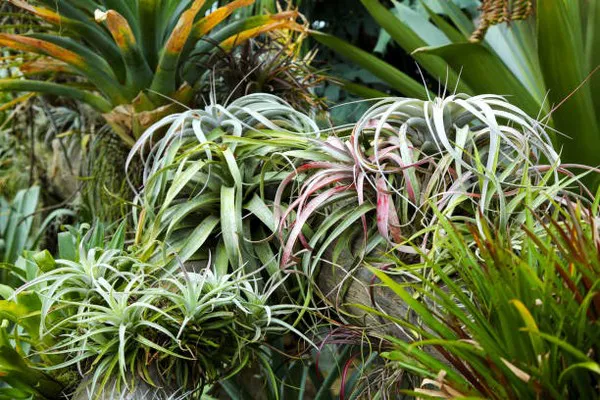In the captivating realm of botanical wonders, air plants, scientifically known as Tillandsia, hold a special place. These unique epiphytes have intrigued and delighted enthusiasts and horticulturists alike with their remarkable ability to thrive without soil, drawing nutrients and moisture from the air around them. While their ethereal appearance and minimal care requirements make them popular choices for indoor décor, the question of their growth rate remains a topic of curiosity. How fast do these intriguing plants truly grow? Delve into the world of air plants and uncover the secrets of their growth journey.
The Essence of Air Plants: Unique Epiphytes
Air plants, commonly referred to as Tillandsia, hail from the Bromeliad family and are renowned for their capacity to grow on a myriad of surfaces without the need for soil. Instead, they secure themselves to trees, rocks, or any suitable substrate, absorbing moisture and nutrients from the atmosphere. This distinctive adaptation has earned them the title of “air plants,” capturing the essence of their unconventional mode of sustenance.
Understanding Growth Dynamics
Growth in air plants, like any living organism, is a multifaceted process influenced by various factors. These factors contribute to the uniqueness of each air plant’s growth rate, making it a captivating study in the realm of botany. While it is challenging to pinpoint an exact growth rate applicable to all air plants universally, exploring the general parameters can provide insight into their journey from pup to maturity.
The Growth Phases of Air Plants
Air plants undergo a series of growth phases, each contributing to their eventual maturity. Understanding these stages sheds light on the factors that influence their growth rate.
Pup Formation:
The life cycle of air plants commences with the emergence of pups, also known as offsets or baby air plants. These miniature versions sprout from the base of the parent plant and are essentially its offspring. The timing of pup formation varies between species and environmental conditions. Pups can appear as small shoots, resembling miniature versions of the mature plant.
Pup Growth:
Once pups are established, they embark on their growth journey. The rate at which pups grow can differ significantly depending on factors such as light, humidity, temperature, and available nutrients. Adequate care and a suitable environment are essential for nurturing healthy pup growth.
Maturation:
With time, proper care, and favorable conditions, pups transform into mature air plants. The duration of this phase varies, and it’s during this stage that the plant develops its characteristic features, such as its vibrant foliage, unique form, and, in some cases, vibrant blooms.
Factors Influencing Growth Rate
Light: Adequate light is crucial for the growth of air plants. While they don’t require direct sunlight, they thrive in bright, indirect light. The amount of light they receive affects their metabolic processes, influencing their growth rate.
Humidity: Air plants draw moisture from the atmosphere through their trichomes, specialized structures on their leaves. Higher humidity levels contribute to faster growth, as it ensures a steady supply of water and nutrients.
Temperature: Moderate temperatures within the range of 50 to 90 degrees Fahrenheit (10 to 32 degrees Celsius) are ideal for air plants. Extreme temperatures can slow down their growth rate or even harm them.
Air Circulation: Adequate air circulation is essential to prevent moisture buildup, which can lead to rot. Good airflow ensures the plant’s health and supports its growth rate.
Nutrition: While air plants don’t rely on soil, they still require nutrients. Regular misting or soaking provides essential minerals that contribute to their growth.
Growth Rate Variability
It’s important to note that the growth rate of air plants can be highly variable even within the same species. Factors such as genetics, environmental conditions, care routines, and the specific stage of growth can all contribute to this variability.
Nurturing Growth: Best Practices
To foster optimal growth in air plants, consider implementing these best practices:
Light: Provide bright, indirect light for a significant portion of the day. Avoid exposing them to harsh, direct sunlight.
Watering: Watering methods include misting, soaking, or a combination of both. Consider your environment and the specific needs of your air plants. It’s important to strike a balance between providing adequate moisture and preventing overwatering.
Air Circulation: Place air plants in areas with good air circulation to prevent moisture buildup and potential fungal issues.
Temperature: Keep air plants in environments with moderate temperatures, avoiding extreme cold or heat.
Fertilization: Provide nutrients to your air plants by misting them with a diluted, water-soluble fertilizer once a month during the growing season.
In Conclusion
The growth rate of air plants is a captivating journey influenced by an intricate interplay of environmental factors and intrinsic characteristics. As these fascinating epiphytes evolve from pups to mature plants, they add a touch of enchantment to any space they inhabit. While their growth pace may vary, the joy of nurturing and witnessing their transformation remains constant, reminding us of the intricate beauty and resilience of the botanical world.


